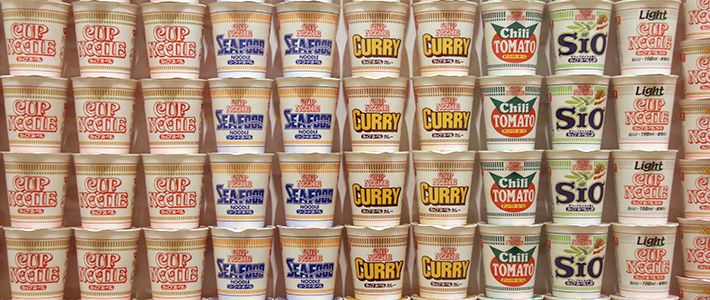
Using Its Noodle for Success: Nissin Food Products
Science Technology Lifestyle- English
- 日本語
- 简体字
- 繁體字
- Français
- Español
- العربية
- Русский
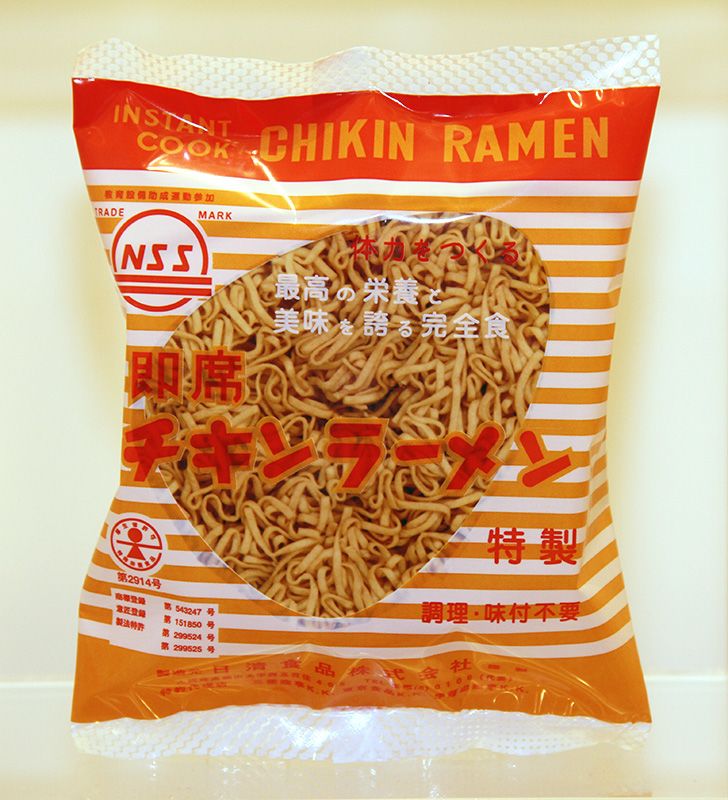 A package of the instant chicken ramen, released in 1958, with a design allowing consumers to see the noodles inside.
A package of the instant chicken ramen, released in 1958, with a design allowing consumers to see the noodles inside.
For many Japanese, living without instant ramen is simply unthinkable. This food item, so easy to prepare and store, perfectly suits the hectic pace of modern life. It was back in 1958 that the founder of Nissin Food Products, Andō Momofuku, came up with the idea for instant ramen. Since then, the noodles have become a favorite of people around the globe, with production spreading overseas. As of 2011, the annual consumption of instant ramen had reached 98 billion packages (according to the World Instant Noodles Association). South Korea has the highest per-capita consumption (at around 74.1 packages a year), while China and Indonesia consume the greatest amount overall.
Just Add Hot Water
All you need to make instant ramen is hot water thanks to the special technique used to dry the noodles.
The instant chicken-flavored ramen noodles invented by Andō were made by boiling and flavoring wheat flour noodles, drying them, and then deep-frying the noodles in oil for two minutes at 160°C. The deep-frying process causes the water in the noodles to boil away rapidly, producing the familiar dried noodles. As the water boils away, it leaves lots of small holes in the dried noodles. Pour boiling water over the noodles and those holes are quickly filled by the permeating water, returning them to the state they were in immediately after the original boiling (Figure 1). The production technique also allows the noodles to be stored for up to six months without being refrigerated because the lack of water in the dried ramen prevents the spread of germs.
 Figure 1: A cross-section of part of a chicken ramen noodle. The boiled noodle (left). When the noodle is deep-fried in oil (middle), the water evaporates and leaves holes inside. The holes fill with hot water (right) so that the noodle returns to its boiled state quickly.
Figure 1: A cross-section of part of a chicken ramen noodle. The boiled noodle (left). When the noodle is deep-fried in oil (middle), the water evaporates and leaves holes inside. The holes fill with hot water (right) so that the noodle returns to its boiled state quickly.
What’s Inside the Cup?
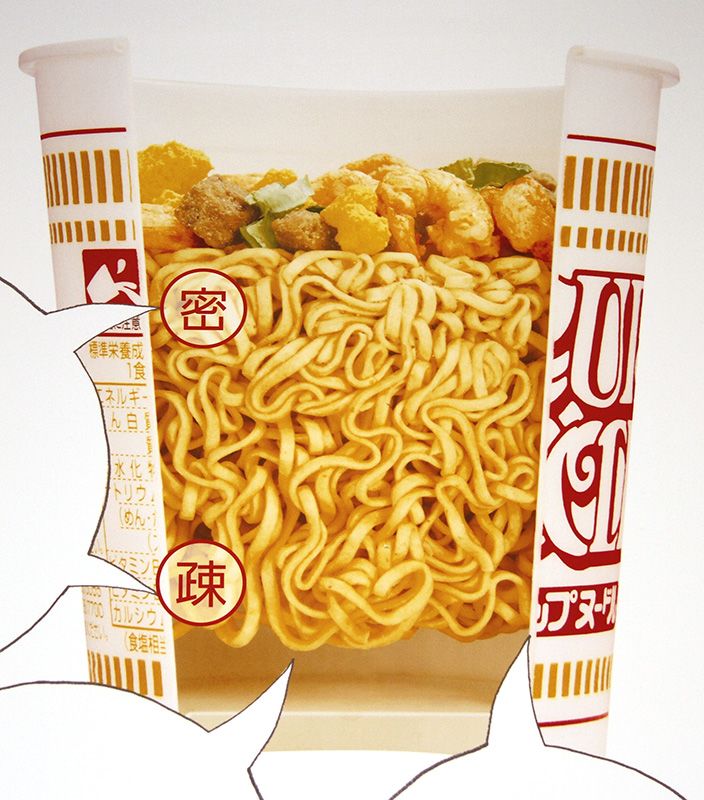 A Cup Noodle cross-section. The noodles rest in the middle of the cup, closely hugging the sides, and they are packed more tightly together near the top of the cup.
A Cup Noodle cross-section. The noodles rest in the middle of the cup, closely hugging the sides, and they are packed more tightly together near the top of the cup.
The next product to appear after the original chicken ramen was Cup Noodle. This product was also invented by Andō, who came up with the idea after a trip to the United States to survey its market. There he saw Americans breaking the dried chicken ramen into chunks, putting them in cups, and then eating with the noodles with a fork. This inspired him to try to package noodles in a cup, which also suited the Japanese custom of eating noodles in a bowl with chopsticks. But commercializing this idea required a new technique to be developed.
Recall that the dried ramen is made by deep-frying noodles that had already been boiled. The noodles would need to be in a lump about six centimeters thick to fit into a cup shape. The problem, though, is that if you deep-fry noodles in that lump shape, the heat does not penetrate adequately to the center; and increasing the heat would only result in burning the edges of the lump of noodles. This problem was overcome by deep-frying the noodles in an iron mold, shaped like an inverted cone with the pointed end removed.
As the noodles fry in the oil, they churn and bounce against the lid of the metal container, eventually settling into the shape of the cup. Thanks to this movement, the heat passes evenly through the noodles. The other merit of the approach is that when the hot water is poured into the cup, it immediately falls through to the bottom, softening the noodles at the bottom first. If you look closely, you can see that the noodles at the top of a cup are bunched tightly together, whereas the noodles at the bottom are more loosely packed.
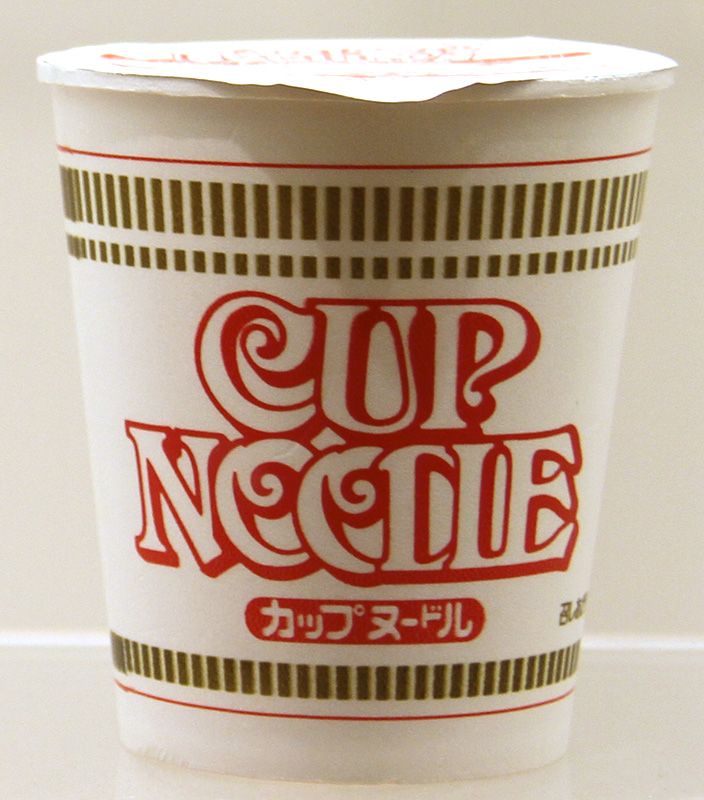 Another unanticipated benefit of the new technique was that other ingredients could be placed at the top, in the space where the noodles had pressed against the lid of the iron mold.
Another unanticipated benefit of the new technique was that other ingredients could be placed at the top, in the space where the noodles had pressed against the lid of the iron mold.
Cup Noodle has become a popular product globally, now sold in 80 countries. The products comes in different versions in order to suit each domestic market. In the United States and Europe, for example, the noodles are shorter to make them easier to eat with a fork, since people there do not slurp up their noodles in the Japanese style. In the case of Muslim countries, like Indonesia, the company is careful to include no traces of pork in the version of Cup Noodle sold there, which has been certified as a Halāl food product.
Still Going Strong After 50 Years
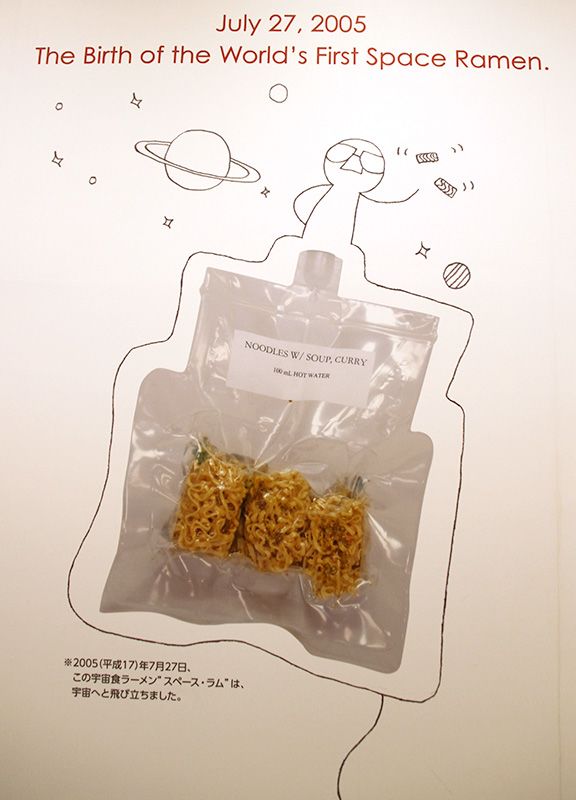 Space Ram instant noodles designed for the astronauts.
Space Ram instant noodles designed for the astronauts.
In 2005, Nissin Foods developed instant noodles for astronauts, called Space Ram. The noodles come in bite-size bundles coated in egg whites to hold them together in a low-gravity environment. The soup was also made thicker to prevent spattering that could spread inside the space vessel. The flavor is quite strong because a person’s sense of taste is dulled in space. The starch content of the flour for the noodles was also adjusted so that the noodles could be cooked with hot, 70°C water; this was necessary because water cannot boil in the space shuttle due to the low air pressure.
Matsuo Tomonao, of Nissin Foods’ Public Relations Department, notes that the methods used to produce Space Ram are not that different from the concept used for the original instant ramen. “For instance, the drying technique used for the very first chicken ramen is still being used today, more than half a century later.” This is a testament to just how groundbreaking Andō’s idea was. He laid the groundwork for the spectacular global success of Cup Noodle in the years that followed, making it today one of Japan’s most widely recognized products.
(Originally written in Japanese by Satō Narumi.)